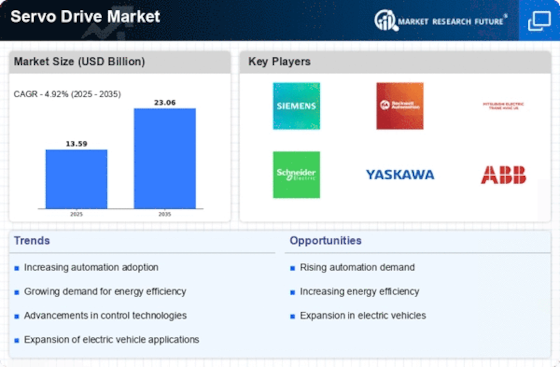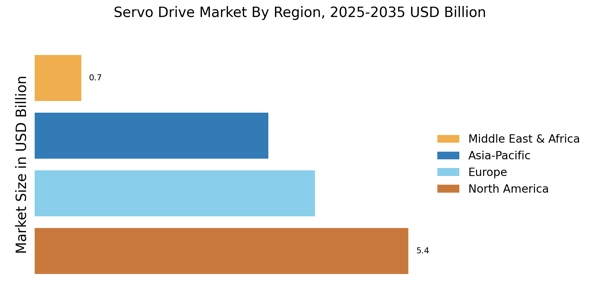Rising Demand for Automation
The Servo Drive Market is experiencing a notable surge in demand for automation across various sectors, including manufacturing, automotive, and robotics. This trend is driven by the need for enhanced efficiency, precision, and productivity in operations. As industries increasingly adopt automated solutions, the demand for servo drives, which provide precise control of motion and speed, is expected to rise. According to recent data, the automation sector is projected to grow at a compound annual growth rate of over 10% in the coming years, further propelling the servo drive market. The integration of servo drives into automated systems not only improves operational efficiency but also reduces downtime, thereby enhancing overall productivity. This growing inclination towards automation is likely to be a key driver for the Servo Drive Market.
Expansion of Electric Vehicles
The Servo Drive Market is witnessing a substantial impact from the expansion of electric vehicles (EVs). As the automotive sector shifts towards electrification, the demand for advanced motion control solutions, including servo drives, is expected to grow. Servo drives play a critical role in the operation of electric vehicles, particularly in applications such as steering, braking, and powertrain control. The Servo Drive is projected to grow at a compound annual growth rate of over 20% in the next decade, which will likely drive the demand for servo drives. This transition towards electric mobility not only enhances vehicle performance but also aligns with broader sustainability goals. Consequently, the expansion of the electric vehicle market is poised to be a significant driver for the Servo Drive Market.
Increased Investment in Robotics
The Servo Drive Market is benefiting from increased investment in robotics across various sectors, including manufacturing, healthcare, and logistics. As companies seek to enhance operational efficiency and reduce labor costs, the adoption of robotic systems is becoming more prevalent. Servo drives are integral to the functionality of these robotic systems, providing the necessary precision and control for various applications. Recent data suggests that The Servo Drive is expected to grow at a rate of approximately 15% annually, which will likely boost the demand for servo drives. This trend is further supported by advancements in robotic technologies, such as collaborative robots and autonomous systems, which require sophisticated motion control solutions. The rising investment in robotics is anticipated to be a key driver for the Servo Drive Market.
Growing Focus on Energy Efficiency
The Servo Drive Market is increasingly influenced by a growing focus on energy efficiency. As industries strive to reduce operational costs and minimize their environmental impact, the demand for energy-efficient servo drives is on the rise. These drives are designed to optimize energy consumption while maintaining high performance levels, making them an attractive option for manufacturers. Recent studies indicate that energy-efficient servo drives can reduce energy consumption by up to 30%, which is a significant incentive for companies looking to enhance their sustainability efforts. Additionally, regulatory pressures and incentives for energy-efficient technologies are further propelling the adoption of servo drives. This emphasis on energy efficiency is expected to be a crucial driver for the Servo Drive Market, as businesses increasingly prioritize sustainable practices.
Technological Advancements in Servo Drives
Technological advancements are playing a pivotal role in shaping the Servo Drive Market. Innovations such as the development of more compact, efficient, and intelligent servo drives are enhancing their performance and applicability. The introduction of digital servo drives, which offer superior control and feedback mechanisms, is particularly noteworthy. These advancements enable manufacturers to achieve higher levels of precision and responsiveness in their applications. Furthermore, the integration of IoT and AI technologies into servo drives is expected to revolutionize their functionality, allowing for real-time monitoring and predictive maintenance. As a result, the market for servo drives is anticipated to expand significantly, with projections indicating a growth rate of approximately 8% annually over the next five years. This continuous evolution in technology is likely to be a driving force in the Servo Drive Market.

















Leave a Comment